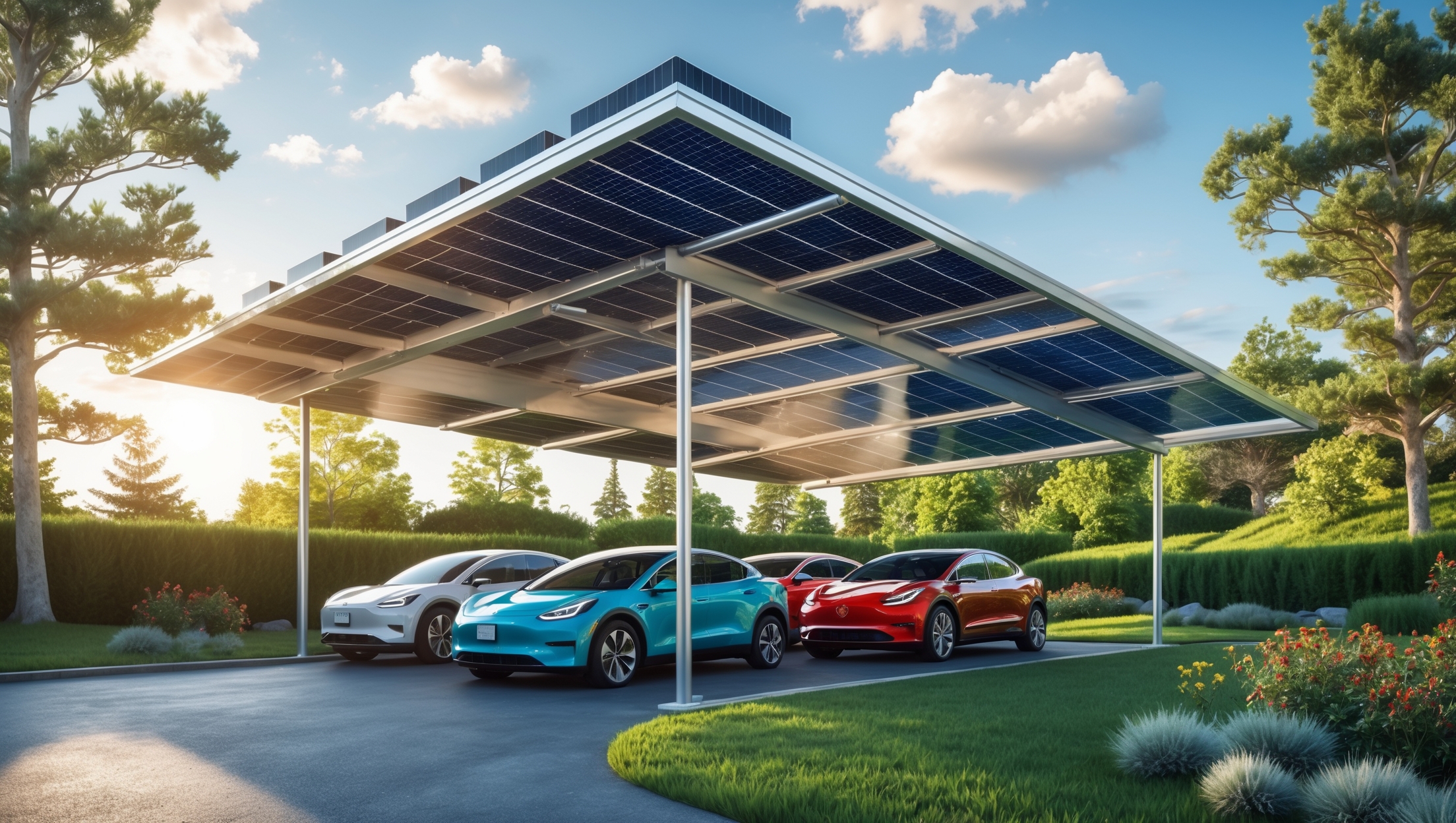Introduction: Why Solar Carports Are the Next Big Thing in Sustainable Living
Solar carports are rapidly emerging as one of the most practical and innovative solutions for homeowners who want to merge sustainable energy generation with convenient vehicle protection. Unlike traditional solar arrays, solar carports transform otherwise underutilized driveway or parking space into a dual-purpose asset: shelter for your car and a renewable energy generator for your home or electric vehicle (EV). As the adoption of electric vehicles accelerates and residential solar power becomes more affordable, the appeal of solar carports is growing. However, many homeowners make critical missteps during planning, installation, and maintenance—errors that can reduce energy output, increase costs, or compromise safety. In this comprehensive guide, we’ll examine the most common mistakes to avoid when installing a home solar carport, backed by expert insights and actionable advice. Whether you’re considering a DIY build or hiring professionals, understanding these pitfalls will ensure you maximize your investment, avoid costly rework, and enjoy years of reliable, green power.
Understanding Solar Carports: The Basics
What Is a Solar Carport?
A solar carport is a structure designed to shelter vehicles while supporting photovoltaic (PV) panels on its roof. Unlike rooftop solar, carports are typically ground-mounted, allowing for optimal panel orientation and tilt. They can be sized for one or more vehicles and may be connected to your home’s electrical system, your EV charger, or even function as a grid-tied or off-grid power source.
How Do Solar Carports Differ from Other Solar Installations?
- Purpose-Built Structure: Engineered for both vehicle protection and solar energy generation.
- Flexible Location: Can be installed where roof solar is impractical due to shading or roof condition.
- Customizable Orientation: Panels can be positioned for maximum sunlight, unlike fixed-roof arrays.
- Integrated EV Charging: Directly supports electric vehicle owners.
Beginner Pitfall #1: Underestimating Local Zoning and Permitting Requirements
One of the most common mistakes is failing to research and comply with local zoning laws, HOA restrictions, and permitting processes. Each municipality may have unique requirements regarding structure height, proximity to property lines, foundation type, and electrical work. Without proper permits, you risk fines, forced removal, or issues when selling your home.
How to Avoid:
- Consult your city or county permit office before finalizing any plans.
- Check with your Homeowners Association (HOA) for any restrictions or design guidelines.
- Work with a licensed contractor experienced in solar and carport construction who can handle permitting.
- Factor in extra time for permit approvals in your project timeline.
Beginner Pitfall #2: Ignoring Sunlight Analysis and Shading Issues
Solar carports must be sited and oriented to maximize sunlight exposure throughout the year. A surprising number of installations underperform because trees, buildings, or even the house itself cast shade during peak sunlight hours. Unlike rooftop solar, you can choose where to build your carport—take full advantage of this flexibility.
How to Avoid:
- Use solar pathfinder tools, apps, or professional surveys to assess sun exposure for all seasons.
- Trim or remove shading trees if permitted and practical.
- Orient the carport (ideally south-facing in the northern hemisphere) for maximum daily exposure.
- Account for potential future obstructions—new construction, tree growth, etc.
Beginner Pitfall #3: Under-Sizing the System for Current and Future Needs
Many homeowners install a system that barely covers their current energy or EV charging needs, not accounting for future lifestyle changes, additional vehicles, or battery storage. This can lead to expensive upgrades or missed opportunities to offset more of your home’s energy consumption.
How to Avoid:
- Calculate your current energy usage, including average and peak loads.
- Plan for future needs: additional EVs, battery storage, or increased home consumption.
- Choose modular designs that allow for easy expansion.
- Consult with solar integrators who can help model different scenarios.
Beginner Pitfall #4: Skimping on Structural Engineering and Wind/Snow Load Ratings
Carports must withstand local weather conditions, including wind, snow, and seismic events. Undersized structural components or improper anchoring can lead to catastrophic failure—destroying your investment and creating significant safety hazards.
How to Avoid:
- Have the structure designed or reviewed by a licensed structural engineer familiar with solar carports.
- Ensure the design meets or exceeds local building codes for wind, snow, and seismic loads.
- Don’t cut corners on materials—galvanized steel or heavy-duty aluminum are preferred for durability.
- Use certified mounting systems for PV panels rated for your area’s weather challenges.
Beginner Pitfall #5: Overlooking Electrical Safety and Grid Integration
Improper electrical work is a leading cause of system failures, reduced performance, or even fire risk in solar carport installations. Amateur wiring, incorrect inverter sizing, or failure to coordinate with your utility can result in non-compliance, poor efficiency, or hazardous conditions.
How to Avoid:
- Always hire a licensed electrician with experience in residential solar installations.
- Ensure all components—panels, inverters, wiring—are UL-listed and approved for grid-tied use.
- If installing battery backup or off-grid capability, use only compatible and certified equipment.
- Notify your utility and follow interconnection procedures for grid-tied systems.
- Install dedicated surge protection and proper grounding.
Beginner Pitfall #6: Neglecting Drainage and Water Management
Poorly designed carports can channel water directly onto vehicles, walkways, or adjacent structures. This is not only inconvenient but can also create slip hazards and accelerate wear on your home and carport foundation.
How to Avoid:
- Design the roof with an appropriate pitch to direct water away from driveways and structures.
- Install gutters and downspouts to manage runoff.
- Consider integrating a rainwater harvesting system for garden irrigation.
- Use permeable pavers or gravel under the carport to reduce standing water.
Beginner Pitfall #7: Foregoing Maintenance Planning
Solar carports are low-maintenance compared to other systems, but neglecting routine inspection and cleaning can lead to reduced output, safety issues, and costly repairs.
How to Avoid:
- Schedule biannual cleaning of solar panels to remove dust, pollen, and bird droppings.
- Inspect mounting hardware, electrical connections, and the structure for signs of wear or corrosion.
- Check gutter systems for blockages, especially after storms.
- Keep an annual maintenance log and address issues promptly.
Beginner Pitfall #8: Underestimating Budget and True Project Costs
Many homeowners overlook soft costs—such as engineering, permitting, site prep, and utility fees—when budgeting for a solar carport. Others fail to account for the cost of additional features like integrated lighting or EV charging equipment.
How to Avoid:
- Request itemized quotes from multiple contractors to compare costs.
- Include a 10-15% contingency for unexpected expenses.
- Research local incentives or rebates to lower your out-of-pocket costs.
- Consider long-term savings from reduced energy bills to offset higher upfront investment.
Beginner Pitfall #9: Choosing the Wrong Panel Type or Inverter Technology
The type of solar panel and inverter you choose can greatly affect system performance and lifespan. Some panels perform better in partial shade; others are more efficient in high temperatures. Inverters must be properly matched to the system size and your energy goals.
How to Avoid:
- Consult your installer about panel efficiency, shade tolerance (e.g., microinverters or optimizers), and warranty.
- Choose panels with high temperature coefficient ratings for hot climates.
- Ensure inverter capacity matches your carport’s output and anticipated expansion.
- Opt for reputable brands with strong warranties and local support.
Beginner Pitfall #10: Neglecting Aesthetics and Neighborhood Compatibility
While function is paramount, ignoring the appearance of your solar carport can create tension with neighbors or reduce curb appeal. Unsightly or out-of-place structures may draw complaints or impact property value.
How to Avoid:
- Choose designs that complement your home’s architecture and landscape.
- Consider color-matched materials and low-profile mounting systems.
- Involve neighbors early if your project will be visible from shared spaces.
- Plant native shrubs or install lattice panels to soften the visual impact as needed.
Expert Tips for a Successful Solar Carport Installation
- Engage Professionals: Hire experienced solar designers and contractors with a portfolio of similar projects.
- Plan for Expansion: Leave space for additional panels or EV charging as your needs grow.
- Integrate Smart Technology: Add energy monitoring, automated lighting, or app-controlled EV chargers for convenience and efficiency.
- Leverage Incentives: Stay updated on federal, state, and local rebates or tax credits to reduce costs.
Conclusion: Installing a Solar Carport—Success Is in the Details
Solar carports represent a powerful step forward in sustainable living, offering both environmental and financial rewards. However, the path to a successful installation is paved with careful planning, attention to detail, and a willingness to address challenges proactively. By avoiding the common mistakes outlined in this guide—from inadequate site assessment and underestimating future needs to neglecting maintenance and aesthetics—you position yourself for a smooth project and years of dependable green power. Remember, every home and site is unique; what works for one installation may not suffice for another. Engage qualified professionals, leverage technology, and look beyond the initial build to long-term performance and value. With thoughtful preparation, your solar carport can become a cornerstone of your sustainable home—delivering energy savings, vehicle protection, and peace of mind for years to come. Invest the time now to avoid costly missteps, and you’ll reap the full benefits of this smart, eco-friendly upgrade.





You mentioned that solar carports allow for optimal panel orientation compared to rooftop systems. How much of a difference does the panel tilt and placement actually make in terms of energy output for a typical home installation?
Panel tilt and placement play a big role in how much energy your solar carport generates. Unlike rooftops, carports can be angled perfectly to match your location’s ideal tilt and face true south (in the northern hemisphere), maximizing sunlight exposure. This optimal setup can boost energy output by 10–25% compared to panels forced to match a less-than-ideal roof slope or orientation.
Could you elaborate on how solar carports tie into a home’s electrical system versus being used solely for EV charging? I’m wondering if choosing one approach over the other affects the complexity or permits needed for installation.
Solar carports can either be integrated into your home’s electrical system to supply power throughout your house or be dedicated solely for charging an EV. Connecting to the home’s electrical system is more complex, often requiring additional permits, inspections, and possibly utility approval. Using a carport only for EV charging—especially with an off-grid setup—is generally simpler, but limits your usage to just the vehicle. Your choice affects both installation complexity and the permitting process, so be sure to check local regulations.
I noticed you highlighted orientation and tilt as advantages of carports. For locations with frequent snowfall or shade, what adjustments or structural choices help maintain optimal output year-round?
For snowy areas, choosing a steeper tilt angle (usually between 30-45 degrees) helps snow slide off more easily, keeping panels exposed to sunlight. In locations with shade, position the carport to minimize shadowing, possibly raising its height or selecting a site with maximum sun. Additionally, opt for higher-efficiency panels and consider bifacial modules, which can capture some reflected light. Regular maintenance is also key for optimal year-round output.